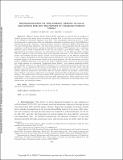Homogenization of the Poisson--Nernst--Planck equations for Ion Transport in Charged Porous Media
Author(s)
Schmuck, Markus; Bazant, Martin Z.
DownloadSchmuck-2015-Homogenization.pdf (931.5Kb)
PUBLISHER_POLICY
Publisher Policy
Article is made available in accordance with the publisher's policy and may be subject to US copyright law. Please refer to the publisher's site for terms of use.
Terms of use
Metadata
Show full item recordAbstract
Effective Poisson--Nernst--Planck (PNP) equations are derived for ion transport in charged porous media under forced convection (periodic flow in the frame of the mean velocity) by an asymptotic multiscale expansion with drift. The homogenized equations provide a modeling framework for engineering while also addressing fundamental questions about electrodiffusion in charged porous media, relating to electroneutrality, tortuosity, ambipolar diffusion, Einstein's relation, and hydrodynamic dispersion. The microscopic setting is a two-component periodic composite consisting of a dilute electrolyte continuum (described by standard PNP equations) and a continuous dielectric matrix, which is impermeable to the ions and carries a given surface charge. As a first approximation for forced convection, the electrostatic body force on the fluid and electro-osmotic flows are neglected. Four new features arise in the upscaled equations: (i) the effective ionic diffusivities and mobilities become tensors, related to the microstructure; (ii) the effective permittivity is also a tensor, depending on the electrolyte/matrix permittivity ratio and the ratio of the Debye screening length to the macroscopic length of the porous medium; (iii) the microscopic convection leads to a diffusion-dispersion correction in the effective diffusion tensor; and (iv) the surface charge per volume appears as a continuous “background charge density,” as in classical membrane models. The coefficient tensors in the upscaled PNP equations can be calculated from periodic reference cell problems. For an insulating solid matrix, all gradients are corrected by the same tensor, and the Einstein relation holds at the macroscopic scale, which is not generally the case for a polarizable matrix, unless the permittivity and electric field are suitably defined. In the limit of thin double layers, Poisson's equation is replaced by macroscopic electroneutrality (balancing ionic and surface charges). The general form of the macroscopic PNP equations may also hold for concentrated solution theories, based on the local-density and mean-field approximations. These results have broad applicability to ion transport in porous electrodes, separators, membranes, ion-exchange resins, soils, porous rocks, and biological tissues.
Date issued
2015-06Department
Massachusetts Institute of Technology. Department of Chemical Engineering; Massachusetts Institute of Technology. Department of MathematicsJournal
SIAM Journal on Applied Mathematics
Publisher
Society for Industrial and Applied Mathematics
Citation
Schmuck, Markus, and Martin Z. Bazant. “Homogenization of the Poisson--Nernst--Planck Equations for Ion Transport in Charged Porous Media.” SIAM Journal on Applied Mathematics 75, no. 3 (January 2015): 1369–1401. © 2015 Society for Industrial and Applied Mathematics
Version: Final published version
ISSN
0036-1399
1095-712X